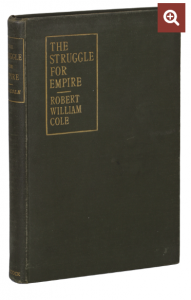A few weeks back, an old bud named Tomas Diaz posted a brief essay by Hilaire Belloc, titled “On Fantastic Books“. It is an early 20th century defense of the fantasy genre from a great thinker, and you can read it in full for yourself. It is well worth an essay in its own right, but today we’re keying in on this phrase right here:
I confess that I care nothing whether they are well written or ill written; so long as they are written in any language that I can understand I will read them; and today as I write I have before me a notable collection of such, every one of which I have read over and over again. I remember one called the Anglo-Saxon Conquest of the Solar System or words to that effect.
 Turns out the words to that effect are The Struggle for Empire: A Story of the Year 2236. Written in the 19th century by Robert William Cole, and published in the year 1900, a physical copy will set you back a cool $4,500. Or you can grab a free copy from Google Books right here. There are a couple of places it can be found online in HTML, but if you click on the red button to the left, you can grab an EPUB and convert to your favorite reader for easy reading.
Turns out the words to that effect are The Struggle for Empire: A Story of the Year 2236. Written in the 19th century by Robert William Cole, and published in the year 1900, a physical copy will set you back a cool $4,500. Or you can grab a free copy from Google Books right here. There are a couple of places it can be found online in HTML, but if you click on the red button to the left, you can grab an EPUB and convert to your favorite reader for easy reading.
It tells the story of an Earth united under the benevolent bootheel of an Anglo-Saxon empire that won World War I so handily, thanks to a US-Brit-German alliance, that everybody fell in behind the Brits. Then they went out into the stars where they found enough room to spread out, colonize, get into internecine spats, take up a little piracy, and generally make a decent run at conquering the galaxy. And then the Sirians show up.
Before we get to the massive Anglo-Sirian war, we should talk a little bit about the style of the story. Unlike modern tales that select a couple of point-of-view character for the reader to experience the war through, Cole uses the omniscient narrator to cut back and forth between two different levels of the conflict. In a few chapters he explains how the conflict affects a love triangle between the worthwhile lady love, who chooses the dashing officer over the broody Brainiac. Halfway through the war, complications ensue, and that story wraps up in a short chapter at the tail end of the piece. All told, the human-level story takes up maybe a quarter of the novel. Cole has other things to discuss.
In between these few chapters, the reader gets a solid history of the galaxy between the year 1900 and 2236. Cole also sets the ground rules for the technology, explaining that scientists have managed to create or discover three new forces, Dynogen, Pralion, and Ednogen. With them, mankind manages to create incredible works of engineering, including ships that can sail through the void of space, send messages at greater than light speed, manage anti-gravity, and blast each other to smithereens. He stresses early on that space is really, really big, and that even with all of their technology, mankind requires great lengths of time to sail between the stars – months even!
And then Cole launches a massive human fleet at Sirius, ready to conquer the first real challenge to humanity’s hegemony. Unfortunately for the Anglo-Saxons, the Sirians are no pushovers on the tech front themselves. They also have a much less fractious interstellar empire to contend with, and so manage to shatter the attacking fleet. Their defense proves strong enough to convince them that the smart play is to conquer the Angl0-Saxons in turn. Thus begins a long and relentless battle that sees:
- Fleets of thousands of space ships flung headlong into days’ long battles
- A rain of debris over the continents, mountains, cities, and seas of Neptune
- In keeping with John C. Wright’s definition of “space opera” the blowing up of not one, but two moons, at the same time
- Three-dimensional naval tactics, and
- The frantic last minute search for a savior weapon that might knock the bombarding Sirian ships out of the tropical skies above London.
Did I mention that the Anglo-Saxons used their tech to move London to more tropical climes? It’s a brief aside in the book, and just one of many like it.
It’s all very Doc E. E. Smith, and it is amazing.
Cole relishes the thought of future-war, and pens a mil-SF story that stands with the best of what is on tap today. If you can set aside your modern prejudices long enough, you’ll find a strangely effective war story of the clash of civilizations. You’ll also find a strangely prophetic vision of the wars of the future. Sure, he gets some of the science wrong – see the above bullet-point about the continents and seas of Neptune – but his extrapolations of what a future war might look like are surprisingly…let us call them anachronistically prescient.
For example, he imagines interstellar ships to resemble submarines. He recognizes that their primary function is to protect crews from the hazards of the void. They are compartmentalized to limit damage in the case of hull breaches. And yet, his magic engines evoke images of propellers rather than jets. Ships do not have energy screens, but torpedo nets. Gun crews must individually load cannons that use rubber gaskets to allow shells to be fired without exposing the crew to the vacuum of space. Most combat occurs over the ridiculously long (by the standards of 1900) ranges measured in miles, with the frequent use of ramming when the opportunity arises. Sometimes ships can hide the dark shadows behind moons. And yet, the War Department has screens that can spot ships in orbit, even during the darkest night.
And sometimes the forces unleashed can wreak a havoc that no one could possibly predict – not even the big brains of 2236 R&D. Remember what I said about the moons blowing up? That wasn’t planned – it was a by-product, and possibly a touch of divine chastisement.
Buried within the high adventure and detailed future-war history, the oberservant reader can spot some interesting Easter Eggs:
- The end of the war brings about a peace that one might recognize from our own histories of the actual WW1
- Cole predates Roddenberry by predicting man would sail into the depths of space in a vain attempt to find God on his Throne
- The somewhat vague forces of Dynogen and Pralion somewhat mimic the strong and weak forces of the subatomic world
- The six year slog through a battle of attrition calls to mind the coming storm of WW1, as do the numbers, which must have seem ludicrous at the time, with fleets of ships rising into the hundreds of battleships and countless support craft.
- The bombardment of London by the untouchable air-superiority of her nemesis evokes the tumult of the Battle of Britain
- The one major land battle fought – on the moon by ships crawling along the surface – evokes the misery and tactics of later tank battles complete with bunkers, digging-in, and mines used to slow attacking forces.

All-in-all this really is a hidden gem that any real scholar of the genre should take a stab at reading. I’ve already name-checked Doc Smith, but one can also find proto-Barsoomian material within its pages. It has the feel of an H.G. Wells novel, albeit one with shallower characters and a deeper insight to changing technology and how the more things change, the more they stay the same.
If nothing else, the work is relatively short, and the inspiring recitation of the movements of massive fleets over vast distances flows smoothly and quickly. It’s a soli mil-SF story in its own right, but rises to new heights when judged from a distance of twelve decades. Not just for what it got right about the future, but for what it can teach us about the minds of our ancestors, and how they viewed their own place in the universe.
